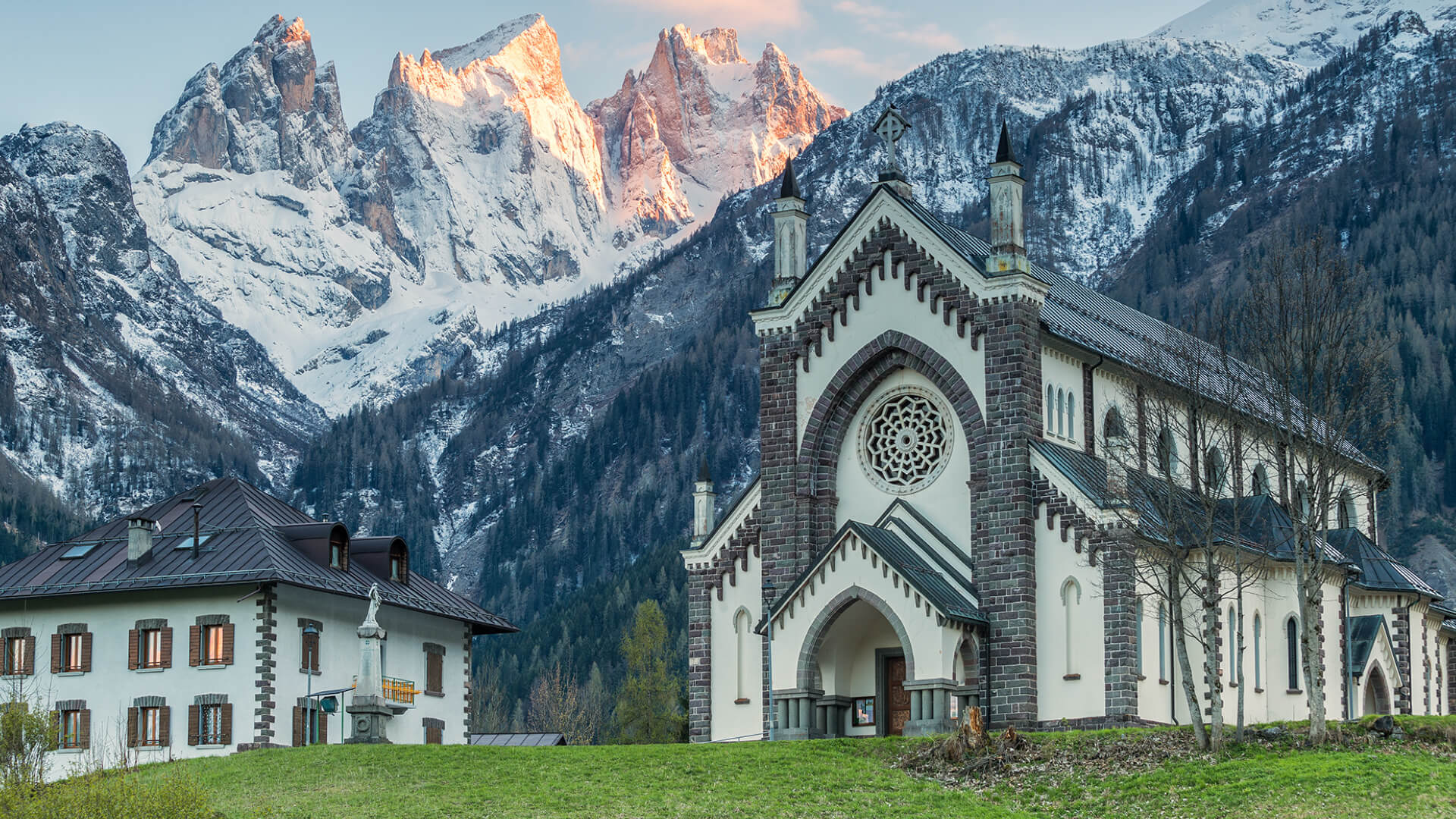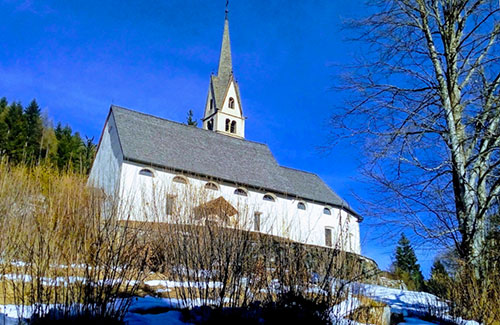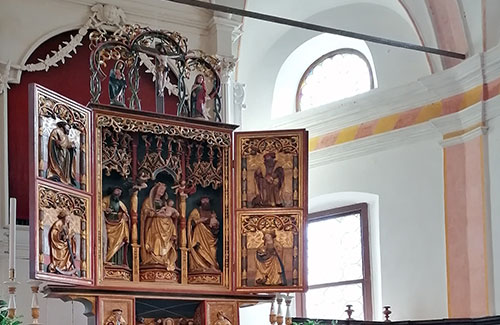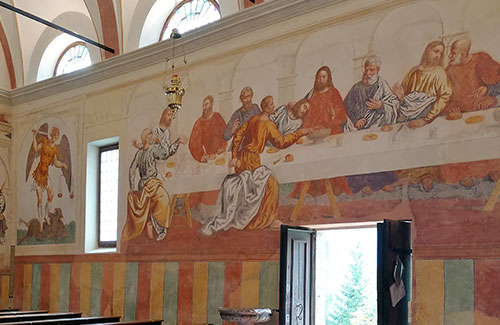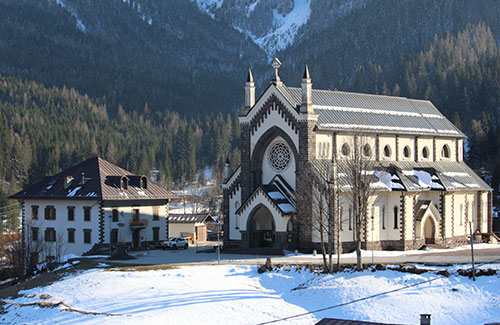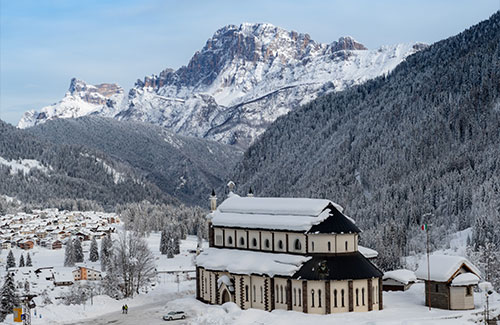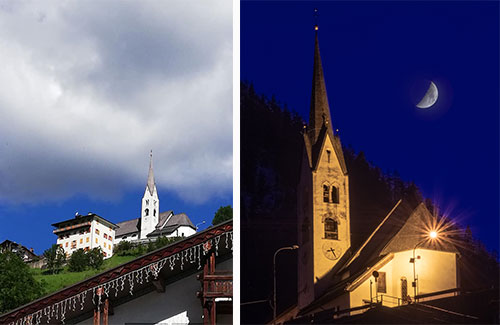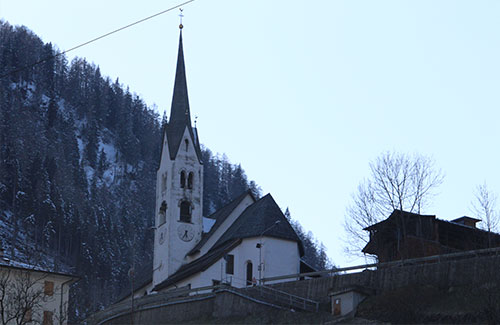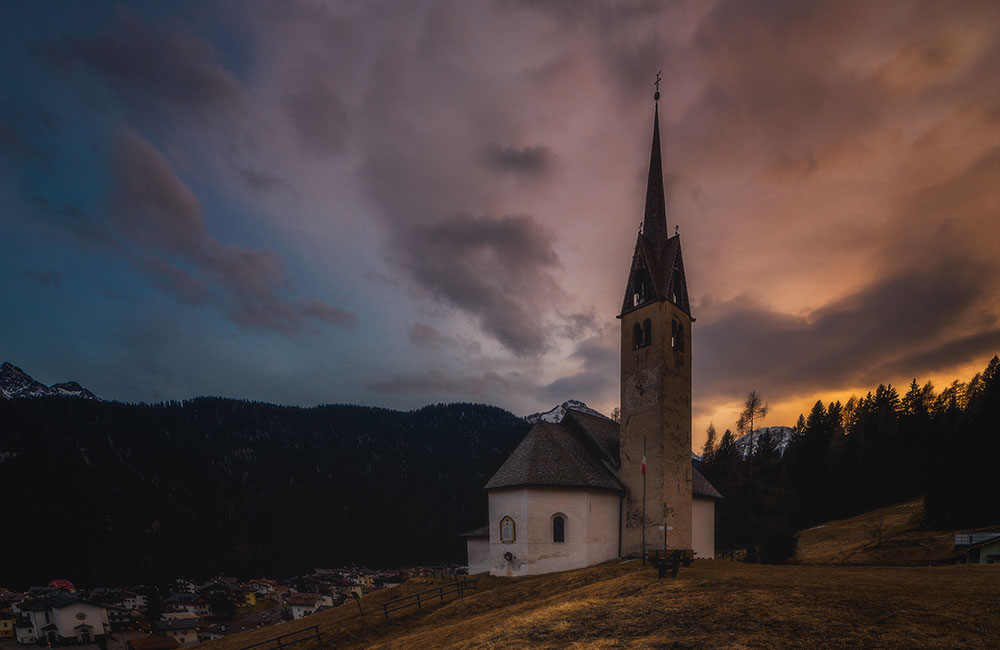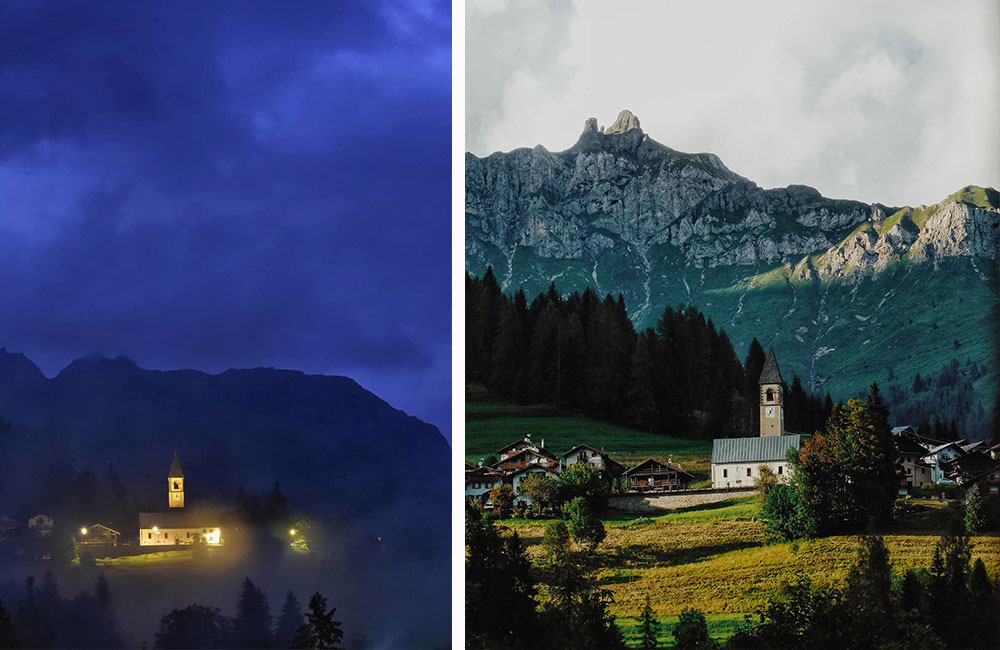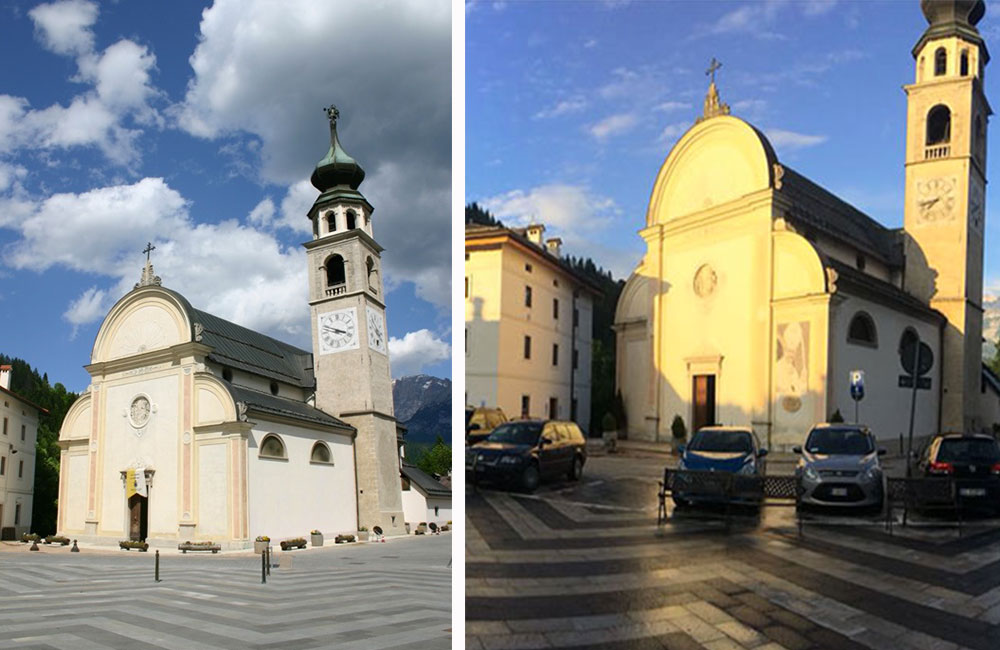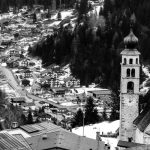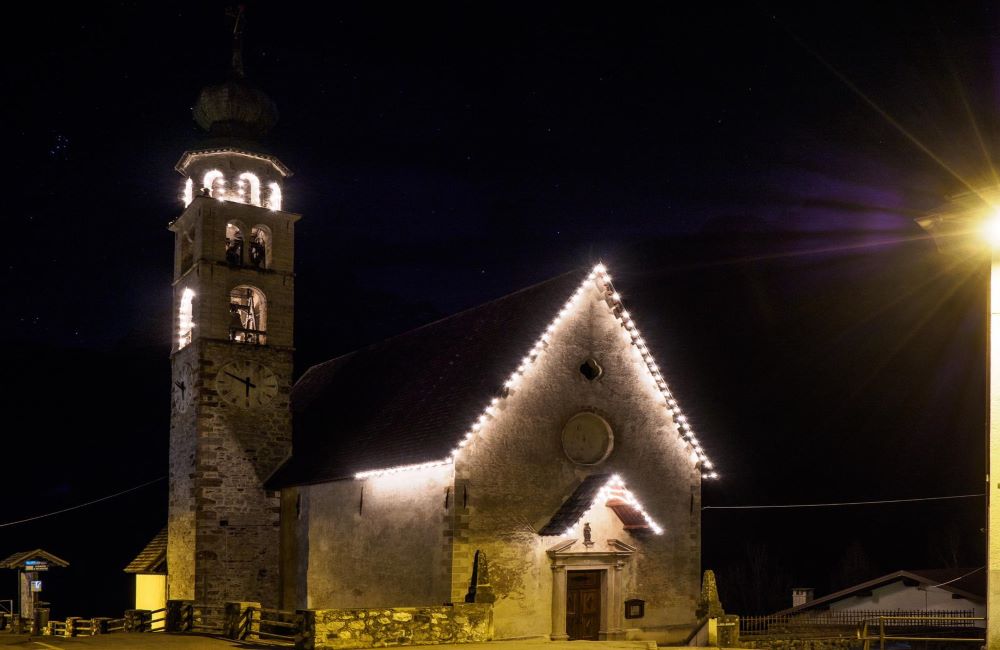CHURCHES IN VAL DEL BIOIS
Val del Biois is rich of churches and other religious elements which enrich the territory and are witness of the great faith of the locals. Many frescos, paintings, sculptures which represent the Saints as protectors from any misfortune.
SAN SIMON CHURCH
VALLADA AGORDINA
This beautiful alpine church lies at the foot of Mount Celentone in the middle of the woods in Vallada Agordina. It was declared National Monument in 1877.
Its origins are very ancient. A legend tells that on 720 a.c. Celentone, a fugitive, gathered around him the pagan people of the valley and he became their guide and begun to talk of Christ. With these people he begun to build a little church dedicated to SS Simone and Taddeo and this was the beginning of Christianity in Val del Biois.
The first written proof about this religious site dates back to 1185 and it is in a papal bull.
Architecture
This is a typical alpine church with a simple architecture. At the very beginning it had a large room with a A-frame roof, a circular apse and a small sacristy. Only in ‘500 this structure was modified and a floor was built under the roof in order to host a beautiful fresco by Paris Bordone.
In this period a precious German style fluegelaltar was arranged in the church.
In 1773 the church was enlarged by some artisans from the nearby town of Moena and the ceiling was entirely covered with frescos.
Next to the Church there is the spectacular little oratory of Confraternità dei Battuti, place where travelers used to stop and pray.
Art works
The church was declared National Monument because of the many valuable art works which enrich San Simon church.
The lateral inner walls of the church are completely covered with frescoes by Paris Bordone, Tiziano’s pupil.
In the presbytery there is a spectacular German style Fluegelaltar, one of the few still well preserved.
Another treasure of the church is the organ by Antonio Callido: it was included in the church in 1802.
BEATA VERGINE IMMACOLATA PARISH CHURCH
FALCADE
It was 1871 when people begun to think of building a new larger church which could host all the people of Falcade. In 1928 on Christmas day during the service the priest read a letter from the Bishop who exorted people to buy a larger church.
In 1946 the new church was blessed and it was dedicated to the Immacolata.
For this occasion the local artist Augusto Murer created the 14 Via Crucis stops and the entrance door.
In 80s the church had many restoration works, the roof was completely restored with a copper covering and thanks to the offer of fellows a new pipe organ was bought.
SAN SEBASTIANO CHURCH
FALCADE ALTO
San Sebastian church overlooks the whole Val del Biois with its gothic alpine style sharp tower bell.
The date of building is uncertain but it was consecrated for sure from 1471 to 1478. It is dedicated to San Sebastiano e San Fabiano, patron saints against terminal illnesses as plague and it was probably a plague who forced people to build a church.
The original church was very small and humble, with only a little fluegelaltar.
At the beginning of XVIII century the church was too small for the fellows, so this was enlarged and also a cemetry was built nearby.
The church was enriched with crosses, altars, statues and a new bell.
During the Napoleonic time the church, as all the other churches, lost many of its precious goods, but these were recovered later paying much money to the soldiers.
The church was further enlarged in 1828 and in 1852 when the inner was completely restored. In 1872 an organ was bought
From 1880 to 1907 the tower bell was reconstructed in its actual gothic alpine style and new bells were bought.
On 8th April 1918 the bells were stolen by Austrian soldiers.
In 1933 Don Augusto Bramezza decided to build a new larger church down in the valley, and this was blessed in 1947. Now San Sebastiano church is a simple site but it remains a working church.
BEATA VERGINE DELLA SALUTE CHURCH
CAVIOLA
Beata Vergine della Salute Church in Caviola lies on a hill in a dominating place surrounded by the trees. It was built by a Venetian priest who left Venice for the peace of the mountains. This is why it was dedicated to Beata Vergine della Salute as the cathedral in Venice.
The church was begun in 1712, finished in 1715 and blessed on 5th August 1732. This day is still now celebrated. The church was very rich inside as a proof of the great value it had among the people.
The church had a bad moment during the Napoleonic time and 8 years later when many treasures were stolen.
In 1834 ca the belltower was restored with the actual gothic alpine style.
Other restoration works were made in 1857, 1887 and 1893.
In 1899 Don Antonio della Lucia bought the 3rd bell. But the bells were all stolen by Austrian soldiers on 8th April 1918.
In 1928 the church was enlarged and the belltower was restored again.
In 1951 the church was closed because of a violent flood and it was substituted with a big pavillon. The population divided into 2 parts: who wanted the church restored and who wanted to leave it degenerate.
In the meantime Sopraintendenza ai monumenti of Venice decided to rebuilt the church but with the original small size. Other works were made in 1969, 1994 and 1997.
The church is still working and it is a pleasant destination for the locals and tourists. It gets a special charm at night with lights which illuminate it.
SAN PELLEGRINO E SANTA CROCE CHURCH
SAPPADE
The church in Sappade was built at the beginning of ‘500 and dedicated to San Pellegrino and Santa Croce.
It was a poor church but with a large painting over the entrance depicting Beata Vergine and her baby between Maria Maddalena and Filomena.
Many important restoration works were made in 1657 and 1686.
In the past time on 3rd May, Santa Croce Day, there was a parade to this church which called people from all the valley and surroundings.
In 1720 a big fire destroyed the church and only the altar was preserved.
Other restoration works were made in 1858 and from 1884 to 1888.
In ’20s the sacresty was restored .
In 1966 the church was damaged by the flood but restored in 1968. In 1978 the church was completely renovated.
SAN GIOVANNI BATTISTA CHURCH
CANALE D’AGORDO
The governors of Val del Biois decided to build a new church which could be more central than San Simon Church in Vallada Agordina which had been the main church of the valley for ages.
This is the reason why the Church in Canale was built. The right date of building is not certain, but the first document which talks of it is dated 1361, so its origin can be placed from 1185 to 1361.
On the major altar there was a German Fluegelaltar and it was specular to the fluegelaltar in San Simon Church.
The church was rich in copper goods probably because it was extracted from the nearby mines.
It was the most important Church of Agordino second only to the church of Agordo.
One of the most rich element in the church is the tabernacol by Andrea Brustolon ( 1969 ), the Michelangelo of Wood.
The election of Albino Luciani as Pope in 1978 brought a revolution in the quiet life of Canale d’Agordo. New restoration works of the church began.
The new altar was built by the local artist Dante Moro for the visit of John Paul II in 1979.
SANT’ANTONIO ABATE CURCH
CENCENIGHE AGORDINO
The church was built in XIII century. At first it was a small gothic building but during the centuries it was restored and enlarged. The actual building dates back to ‘700. This new church was blessed in 1732.
In 1889 the church was completely restored. The central entrance doors were made last century by the local artist Dante Moro and they have a great value.
SAN TOMASO APOSTOLO CHURCH
SAN TOMASO AGORDINO
The church of San Tomaso Agordino dates back to the late Medieval time. The most ancient document which mentions it dates back to 1361.
In 1582 the church was completely covered with frescoes and had a German fluegelaltar which was substituted at the beginning of the XVII century with a painting of the altar by Francesco Frigimelico Senior.
During the years the church was enriched with beautiful and rich furnishings. It still preserves the marvellous Sacresty and the wood choir dated 1718.
The church of San Tomaso Agordino dates back to the late Medieval time. The most ancient document which mentions it dates back to 1361.
In 1582 the church was completely covered with frescoes and had a German fluegelaltar which was substituted at the beginning of the XVII century with a painting of the altar by Francesco Frigimelico Senior.
During the years the church was enriched with beautiful and rich furnishings. It still preserves the marvellous Sacresty and the wood choir dated 1718.



 Webcam
Webcam Weather
Weather Lifts
Lifts

